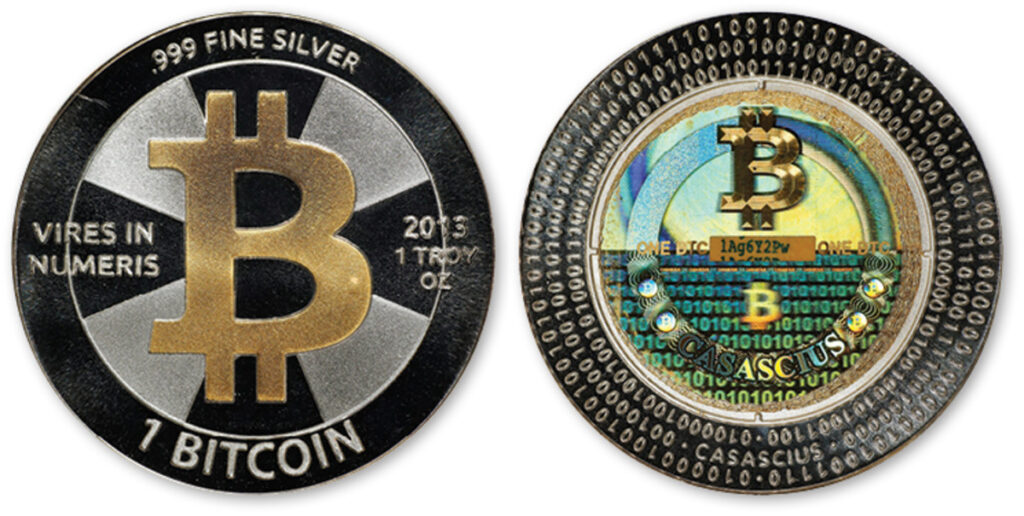In the digital world of cryptocurrencies, where everything from transactions to tokens exists solely in the virtual realm, the concept of physical crypto coins may seem contradictory. Yet, these tangible representations of digital assets have gained popularity for both collectors and crypto enthusiasts alike. While they don’t hold actual cryptocurrency on them, these physical coins symbolize ownership and provide a unique way to engage with the world of crypto. In this article, we will explore what physical crypto coins are, their significance, and why they’ve become a unique niche in the blockchain world.
What Are Physical Crypto Coins?
Physical crypto coins are collectible items that represent various cryptocurrencies, such as Bitcoin, Ethereum, or Litecoin. These coins are often made from materials like brass, silver, or even gold, and come with intricate designs representing the logo or theme of a particular cryptocurrency. What makes these coins special is that some versions are embedded with a private key or QR code that corresponds to a digital wallet, allowing the owner to access real cryptocurrency stored on the blockchain.

However, it’s important to note that most physical crypto coins are purely symbolic, designed for aesthetic appeal or collection purposes. These coins don’t usually contain any actual crypto value unless specifically designed to hold a private key. For many collectors, owning a physical version of a digital asset serves as a tangible connection to an otherwise intangible currency, blending the old-world charm of coin collecting with the cutting-edge technology of blockchain.
The Appeal of Physical Crypto Coins to Collectors
For collectors, physical crypto coins hold significant value beyond their monetary worth. Many coins are produced in limited editions, making them rare and highly sought after in both the crypto community and the wider numismatic world. Each coin’s design often incorporates the iconography of the cryptocurrency it represents, sometimes featuring detailed engravings, holograms, and unique serial numbers to authenticate its rarity. These coins are often displayed as novelty items, reflecting the owner’s involvement in the ever-evolving world of cryptocurrency.
Beyond their collectible nature, physical crypto coins also serve as a conversation starter for those curious about digital assets. They offer a tangible way for crypto enthusiasts to showcase their passion for blockchain technology, and in some cases, these coins have even become a form of art. With various manufacturers offering custom designs, owning a physical crypto coin is a way to express both admiration for cryptocurrency and the innovation it represents.
Practical Uses and Limitations of Physical Crypto Coins
While most physical crypto coins are purely symbolic, some have practical uses, especially in the early days of Bitcoin. For instance, the famous Casascius coins, created by Mike Caldwell, contained a private key that allowed the holder to access real Bitcoin. These physical coins served as a bridge between the virtual and physical worlds, giving users a secure way to store and transfer cryptocurrency. However, regulatory concerns eventually halted the production of such coins, as they were seen as a form of issuing currency.
Despite their appeal, there are limitations to physical crypto coins. First, they are often more valuable as collectibles than as tools for holding digital assets. Since they don’t offer the same security features as digital wallets or cold storage devices, physical coins are vulnerable to loss, theft, or damage. Additionally, the inclusion of a private key or QR code in a physical coin means that, once redeemed, the coin loses its cryptocurrency value, becoming merely a collectible item.
Physical crypto coins represent a fascinating intersection of tradition and modern innovation. While the world of cryptocurrencies largely exists in the digital domain, these coins offer enthusiasts a tangible way to engage with their favorite currencies. Whether admired as collectibles or used to store actual cryptocurrency, physical crypto coins embody the blend of past and future—uniting the artistry of coinage with the transformative power of blockchain technology.

As crypto continues to grow in both popularity and complexity, physical crypto coins offer a unique way to commemorate the digital revolution. Whether you’re a collector, a crypto investor, or simply curious about the evolving landscape, these coins serve as a lasting reminder of the impact digital assets have had on the financial world.
Tables
| Material | Common Uses | Value |
|---|---|---|
| Brass | Collectible items | Low to moderate |
| Silver | Collectible and investment | Moderate to high |
| Gold | Investment and collectibles | High |
| Coin Type | Private Key | Symbolic Value | Collectible Value |
|---|---|---|---|
| Casascius Coins | Yes | High | High |
| Bitcoin Replica | No | Moderate | Moderate |
| Limited Edition Coins | No | High | High |
List of Popular Physical Crypto Coin Manufacturers
- Casascius – Known for its early Bitcoin physical coins with embedded private keys.
- CryptoCoins – Offers a range of collectible coins for various cryptocurrencies.
- BitCoin Vault – Specializes in novelty coins that represent different digital currencies.
- CoinMakers – Provides custom designs for crypto coins based on user preferences.
Useful Links
- CryptoSlate: Understanding Crypto Collectibles – Insights into the collectibles market in the crypto space.
- Investopedia: Physical Bitcoin and Cryptocurrency – A comprehensive overview of physical Bitcoin and its implications.
- CoinTelegraph: The Rise of Physical Cryptocurrency – An article discussing the growth of physical cryptocurrencies and their relevance.

